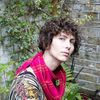2015 is a good year for women artists at the Tate Modern with Agnes Martin opening this week, hot on the heels of Marlene Dumas and Sonia Delaunay.
Martin was an artist whose career was launched when social networking was not a key ingredient to success in the art world. In fact her success as an artist, as a painter was precisely because of her ability to turn her back to the world, as she put it, and focus her mind, empty of thoughts, on her painting. Moreover this was not an age when artists were forever 'emerging', hot and young from art college-cum-businesses ready to be swallowed whole by the hungry global art market. Martin did not begin to paint until she was thirty, and it was not until 1958 that she was given her first solo show, aged forty-five. Indeed these were days when such 'late' career success was not uncommon: Barnett Newman was 43 years old, Willem de Kooning 44, and Franz Kline 40 when they had their first solo shows. But what is interesting about Agnes Martin is her retreat from New York altogether and from art temporarily in 1967, when she moved to New Mexico and gave up painting for five years.
Her retrospective at the Tate is keen to emphasise her mental illness, information that before now was kept quiet. It is hard to know what to make of such biographical details, fitting as neatly as they do into the myth of the tortured artist. There is a feeling that such facts are brought out to tout the authenticity of the artistic intent, to bring the artist in precisely where she, Agnes Martin would not want to be - clouding the minds of the viewers, filling our heads with ideas. Certainly when painting thinking about her self was exactly what she sought to avoid:
"The worst thing you can think about when you're painting is yourself. If you start thinking about yourself, it stands right in the way, in the middle, in front of you and you make mistakes."
"Art" said Agnes Martin "is responded to with emotion. Its not intellectual at all". This is a woman who spent many years meditating; training her self not to think and these paintings are the manifestation of that effort.
"If you wake up in the morning and feel happy with no cause, that is what I paint about. That subtle emotion that we feel without cause in this world."
Often referred to as a minimalist Martin considered herself an abstract expressionist, and these paintings were her expression of joy, a joy she wished to share with her audience, an abstract joy that would remind us that our lives are "broader" that we think.
It is difficult to avoid the narrative biographical arc that is in some ways inherent in a retrospective, played out in art as in life, but on the surface Agnes Martin appears unchanging in both throughout. Progress and evolution were theories she had abandoned: it would be surprising if she applied these notions to her work. Apart from a film there are no great twists and turns, detours into new and diverse territories, materials and mediums, the likes of which can be seen in Delaunay's work in the galleries opposite. In fact Martin went so far as to destroy much of her early work, which included landscapes and portraits. Similarly she avoided participating in, or even knowing about the vicissitudes and dramas of the churning outside world, she did not read newspapers for her final fifty years, and as an adult she always lived alone.
This show inevitably re casts the work as an escape from, or with the schizophrenia with which she struggled throughout her life, and while this may make our lives as cultural consumers more toothsome it is hard to know if it doesn't reduce our experience of art in the process.
